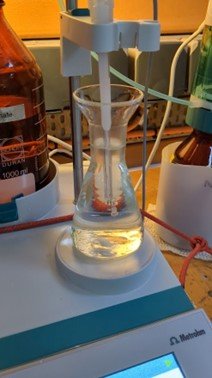Measuring oxygen in seawater | DY174
Did you know that over half of the oxygen on Earth is produced in the ocean? This means it is important to measure the amount of oxygen dissolved in seawater. So, dissolved oxygen analysis is a common part of most ocean expeditions. The data is of interest to physical, chemical and biological oceanographers alike. Physical oceanographers use dissolved oxygen to characterise water masses, that means understand where the water has come from. Chemical oceanographers use it to study how organic material is produced and broken down. Biological oceanographers use the amount of dissolved oxygen in seawater to determine the rate of photosynthesis and respiration.
Oxygen sensors have really improved in recent years, but for the most precise work they still need frequent calibration to correct for drift and the influences of temperature and pressure. This is where taking water samples and lab analysis comes in and what my role onboard RRS Discovery for DY174 was.
The process begins with the CTD (this stands for Conductivity, Temperature and Depth). This is a fundamental oceanographic instrument; it consists of a range of sensors and bottles – known as Niskin bottles - attached to a frame.
CTD frame with sensors and bottle attached
This instrument package is lowered into the water and takes measurements as it descends. As its name suggests, conductivity (a way to calculate the how salty the water is), temperature and depth are measured. Other sensors are also attached to the CTD and measure various other parameters including oxygen concentration. The measured values are displayed on a computer screen for technicians and scientists to see in real time.
Computer screen showing live data measured by the CTD
This information is used to decide where to stop the CTD during on its way back to the surface. At each chosen depth, the CTD is stopped, and a Niskin bottle is closed - by the click of a button - to collect a water sample. Twelve Niskin bottles were attached to the CTD, there is space for another 12 (so a total of 24) but those bottle spaces were used to attach other sensors to the CTD frame so that they could be calibrated either before going onto a mooring or after being recovered. The CTD can be deployed regardless of light levels (this is different to the mooring work which can only be done during daylight) this means I was working around the clock, ready to sample from the CTD whenever it came back on deck. This makes for some great shots of the CTD emerging from the water in the dark.
Depending on the water depth and the length of bottle stops the CTD can take a couple of hours between deployment and remerging from the depths. When the CTD is back on deck, then sampling begins. As oxygen is a gas, it is sampled first. This limits exchange between the water and the atmosphere and minimises the amount of oxygen outgassing from the collected sample because of the pressure change. I took water samples from each Niskin bottle every time there was a CTD cast. It’s also important to take duplicate samples so each station had either 13 or 14 oxygen samples from a range of water depths. Water from the Niskins is carefully filled into special glass bottles and then two chemicals are added, which bind to the oxygen in the seawater. This forms a cloudy mixture not too dissimilar to apple juice (definitely not for drinking through!). Half an hour later the samples get another shake to make sure all the oxygen has bonded with the chemicals. Then a couple of hours later, the oxygen samples are ready to be analysed.
Me taking water samples from the niskin bottles
The analysis method is called Winkler titration and has been adapted from a method first described in 1888 (I love that we’re still using this method today –it has been slightly tweaked and the instruments I use are much more advanced). An acid is added to the oxygen sample to dissolve the particles. This creates a solution with an orange colour where the colour is stronger when there is more oxygen in the seawater. As the titration happens the colour of the solution changes from orange to clear.
The amount of chemical added during titration indicates how much oxygen was initially in the seawater. This is used to calibrate the oxygen sensor on the CTD.
I collected and analysed 150 oxygen samples on DY174. The results will be used to extend oxygen measurements from both CTD casts and the mooring timeseries. As well as measuring the amount of dissolved oxygen in the seawater, I collected water samples for dissolved inorganic carbon (aka amount of CO2 in the water) and nutrients. These samples will be analysed in the labs at the National Oceanography Centre, so it’ll be a little while before the results of these come in.
Me analysing a water sample for the amount of dissolved oxygen






